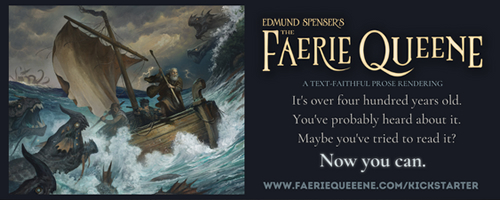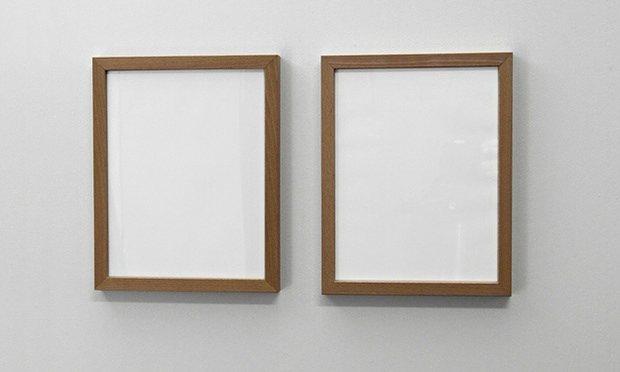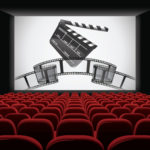The True Aim Of Art
I have a new theory about what’s wrong with modern art. It came to me suddenly, like a flash of insight or a completely random thought. But first, a little background.
Art traditionalists – defined as “people who prefer their art to be recognizable” – have accused modern art of not being true art. This is not always accurate. Sometimes modern art is, quite literally, nothing at all.
A few years ago, the Independent reported on an “invisible exhibition” opened by a

Gianni Motti’s Magic Ink, 1989
London gallery. This gallery consisted of, among other things, a so-called invisible statue of Andy Warhol (actually, a visible but empty plinth Andy Warhol once stepped on); a blank piece of paper at which the artist had stared – “repeatedly over five years,” we are told, though to be realistic, it makes no difference; an “empty space” cursed by a witch; and drawings in invisible ink.
Now, I think I have common sense and all normal people on my side when I say that there is something wrong with this “invisible art”. It frankly seems like a racket, charging money for non-existent statues and blank canvases. I suppose it’s possible the creators are really charlatans who have realized, like the spurious tailors of “The Emperor’s New Clothes”, that people will pay you for nothing if you can only convince them that they are unbearably stupid if they don’t see the Art.
But let’s dismiss that notion, for the sake of charity and even of argument. Let’s assume that the creators genuinely intended art and came up with art that has, as a matter of objective, physical reality, no actual existence. How does an artist end up there, and why – as a school of art – does modern art accept and enable it?
And this is where we return to my theory. I’ve come to wonder if modern art lost its way by pursuing originality.
I’ve long thought that originality is overrated in art, including movies and the written word. This comes partially from my conviction that there is, indeed, nothing new under the sun, that everything that matters is old and everything else is just detail. “It’s been done before,” some people complain. Of course it’s been done before. Everything has been! The question is – how was it done?
 Just as vitally, and not wholly unrelated, I do not regard originality as the true aim of art. The true aim of art is universality. It is to capture and to give voice to lasting truths and utterly human things. When art is great, it expresses something we can all feel, or conveys something we can all understand. It lives in the old things, and makes the old things live to us again.
Just as vitally, and not wholly unrelated, I do not regard originality as the true aim of art. The true aim of art is universality. It is to capture and to give voice to lasting truths and utterly human things. When art is great, it expresses something we can all feel, or conveys something we can all understand. It lives in the old things, and makes the old things live to us again.
The pursuit of originality can mislead artists because it too easily obscures better pursuits. Some art, whether consciously or not, sacrifices universality for originality. Other artists, and not just in the visual arts, forget that people are as much their business as art. More, perhaps. Art that is not enjoyable, or even comprehensible, to people outside a carefully-taught clique fails.
All of this is not to devalue originality but to keep it in its proper place. Originality is like style in that it is something worth having but not usually worth bothering about. The work of a writer is to have something worth saying and then say it as well as he can; do that, and style will come. The work of an artist is to take hold of something timeless, something universal, and give it the best expression possible; originality, too, will come.
And unlike the sort of originality that consists of invisible statues and blank pieces of paper, it won’t come alone.












































I think this is a really good point. It’s very easy for writers to fall into the trap of thinking that when reviewers complain that their work seems derivative, predictable and so on, what they’re asking for is a totally startling new idea that has never been done before, and it’s the writer’s job to try and come up with that idea for their next book. But I think what’s really at issue here is not the familiarity of the tropes or ideas being explored, but the need to come at those tropes and ideas in a fresh way — a freshness that comes not from some contrived and laboured attempt at novelty, but from a deeper level of honesty and relatability.
In other words, the truer our writing is to the way that individual human beings actually think and behave as opposed to the lazy assumptions, stereotypes and cliches about how people of a certain age, culture or ethnic background behave, the more powerful and relatable it will be and the fresher it will seem — even if we’re telling the oldest story in the book as far as the raw material of the plot goes.
I only have an armchair degree in Art, but I have the impression that 50% or so of ultra-modern art is just for the sake of screwing with the audience. But I do admire some of the experimentality of some of it, because it’s less about the visual and more about the psychology.
But I have totes been to an installation where the most accessible piece was the piece of plywood covering a section where they were working on plumbing/electrical underneath. I UNDERSTAND YOU, PLYWOOD.
Yes, I understand what you are saying, up to a point. True artists definitely push the boundaries beyond what people are comfortable with, in that sense they are original. But there is a fine line there between original and ridiculous, sometimes only future generations can tell the difference. As writers we need to be true to the vision of the work that we have, and to tell the story as best we can with the skill that we have. But trying to do something for the sake of being “original” rather than for the sake of the story itself will often derail writers and their work.
I cannot stand modern art. It took some time to figure out why, but I think I have a handle on it. So, let me share…
If art is anything it is communication. Speaking of painting specifically, if you look at the “traditional” painters they are largely representative, but what I find interesting is that anyone could face a painting by Frederick Church, John William Waterhouse, or heck, Vincent Van Gogh and have a good understanding of the piece’s point and/or purpose.
For example, if you were to stand in front of John Singer Sargent’s “Madame X” you do not need to know anything about the history of the painting, the subject, the artist, or anything to keep from falling in love with the striking woman represented on that canvas. (I say that because that is what happened to me.)
But with modern art it is not so much the “art” but the statement, or the artist. Sometimes you need to know the entire body of work of the modern artist to understand what is being said with any one particular piece. …As a stand alone piece of communication modern art fails. So often most people “don’t get it”, and have to be told. (I actually consider much of modern art a con.)
There is an elitism to modern art, a clique of those who are in the know- the privileged few. Yet, with the traditional forms of painting you don’t need to know or understand anything. The works of Michelangelo, Gerome, or Frederick Remington speak for themselves and can be appreciated by both the art aficionado or the mildly interested.
There is also a word that rarely appears when discussion these things, and it’s “discipline”. Winslow Homer spent a lifetime learning his craft. Can we say the same with much of modern art? What skill does it take to create something like Motti’s “Magic Ink”? Literally, none. Why? Because this “art” is not about the product as much as the idea. It is the traditional view inverted.
Which raises a larger point of modern artists pulling the stage down to them rather than trying to climb onto it. It lowers the bar so that EVERYONE can be an artist. …But it’s funny how that only works in the visual arts, not so much in, say, music? A person cannot just pick up a trumpet and blow whatever he likes to express himself and still call it music. So, why do we allow that with this stuff?
Art ought to speak on every level- from the surface to the deep. It is communication, after all. “Traditional” painters do that.
I could go on and on, but I won’t. I’ve had my say. …I feel better now. Thanks.
God bless, all.
I’m evidently a weird person without common sense, because I find the idea of that exhibit interesting. 🙂
Steve, your critique is interesting. I also think that art is essentially communication, but that’s why I tend to give modern art the benefit of the doubt (though sometimes it really is ridiculous). Your critique seems to not so much be “this art isn’t communicating” as “this art is communicating in a complicated, elitist way”. I don’t think there’s innately a problem in artists experimenting with new methods of communication. Perhaps in modern art that’s being driven by an unhealthy desire for originality, or disrespect for tradition or hard work, or elitism – but I don’t think communicating in new ways (even complicated ways requiring a lot of specific knowledge) is necessarily bad. I wish there was room for both traditional art that communicates in familiar ways, and modern art that experiments with different forms of communication. Indeed, experimentation always involves a lot of failure, but eventually it can lead to genuinely good new ideas.
I recently finished a book by Brandon Sanderson, fantasy fiction in a popular style that’s meant to be accessible and entertaining. I enjoyed it, particularly the experience of empathizing with the characters and feeling the excitement and tension of the narrative. At the moment I’m reading James Joyce’s Dubliners, which is definitely not meant to be accessible and entertaining. I’m spending about as much time reading notes and commentary as reading the actual stories. But guess what – I’m enjoying that too. When I read a particular story again after going through all the notes, I am in awe of the tight, subtle power of allusion and metaphor, and the way the story can be about so many things at once even when it’s very short. I’m enjoying it, and it’s communicating with me. I’m just enjoying it a different way, and being communicated to in a different way – one that requires some specific knowledge.
So yes. I wish there was room for both sorts of art, because both can be powerful.
Sheesania…
Thanks for your reply.
One point I’d like to make, however. You said that my critique seems to not so much be “this art isn’t communicating” as much as “this art is communicating in a complicated, elitist way”. I would disagree.
My point (or position) is that much of modern art doesn’t communicate at all. It is vacuous and requires someone “in the know” (the elitist) to shed light on the piece. In essence, to artificially infuse it with value before we can appreciate it.
I should say that I am a professional illustrator and have spent most of my life wandering about the art world. My memories of my art college years- and the years after- are peppered with just such situations. I can recall staring at the most pathetic examples of “art”- a few Barbie dolls stapled to a wall, pornographic collages with human hair mixed in, and other example- and being totally blank as to its “meaning”. (Assuming there was one.)
I do think modern art is deconstructive in nature. It seeks to tear down the stage, as I said, and so make it accessible to all. Motti’s “Magic Ink” is a perfect example. What is the difference between those two frames and two similar frames hanging side by side in a craft shop?
I’ll tell you: it’s the viewer, not the “art”.
But anyway… that’s my take on it. Thanks!
It…well, actually it kind of sounds interesting.
It’s not the individual pieces I guess, but the whole experience of being guided from exhibit to exhibit and made to think briefly on how invisible things have meaning, too. A corner of a room is somehow made a little sinister to know someone had a witch curse it. You think a little about popularity and its shallowness when you look at something generic Warhol stepped on. The exhibit itself is the performance art and is where the meaning lies, the art itself is not very powerful otherwise, and approaches kitsch.